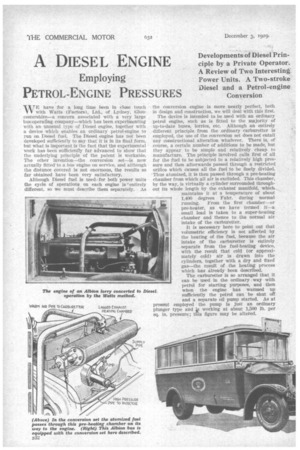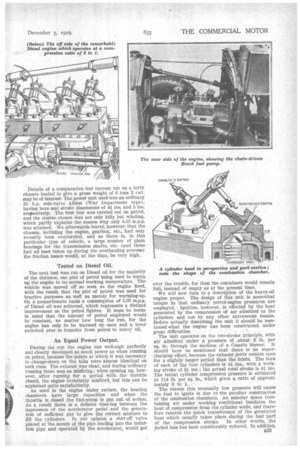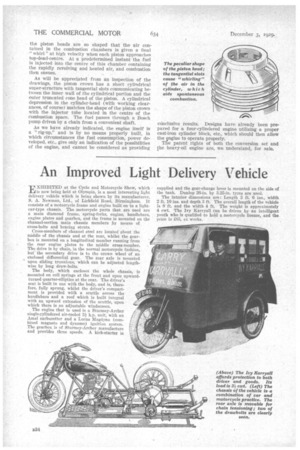A DIESEL ENGINE
Page 58

Page 59

Page 60

If you've noticed an error in this article please click here to report it so we can fix it.
Employing
PETROL-ENGINE PRESSURES
\ATE have for a long time been in close touch V with Watts (Factors), Ltd., of Lydney, Gloucestershire—a concern associated with a very large bus-operafing company—which has been experimenting with an unusual type of Diesel engine, together with a device .which enables an ordinary petrol-engine to rim on Diesel fuel. The Diesel engine has not been developed sufficiently to say that it is in its final form. but what is important is the fact that the experimental work has been sufficiently far advanced to show that the underlying principle of the patent is workable. The other invention—the conversion set—is now actually fitted to a bus engine on service, and although the distance cOvered is not enormous, the results so far obtained have been very satisfactory.
Although Diesel fuel is used.' for both power units the cycle of operations on each engine is 'entirely different, so we must describe them separately. As the conversion engine is more nearly perfect, both in design and construction, we will deal with this first. . The device is intended to be used with an ordinary petrol engine, such as is fitted to the majority of up-to-date buses, lorries, etc. Although an entirely
• different principle from the ,ordinary carburetter is employed, the use of the conversion set does not entail any constructional alteration whatever. There is, of course, a certain number of additions to be made, but they appear to be simple and relatively cheap to manufacture. The principle involved calls first of all for the fuel to be subjected to a relatively high pressure and then afterwards passed through a restricted orifice which causes all the fuel to be -finely divided. 'Thus atomized, it is then passed through a pre-heating chamber from which all air is excluded. This chamber, by the way, is virtually a cylinder surrounded through-. out its whole length by the exhaust manifold, which-_, maintains it at a temperature of about 1,400 degrees Fair. during -normal running. From the first chamber—or pre-heater, as we have termed it—a small lead is taken to a super-heating chamber and thence to the normal air intake of the carburetter.
It is necessary here to point out that volumetric efficiency is not affected by the heating of the fuel, because the air intake of the carburetter is entirely separate from the fuel-heating device, with the result that cold (or approximately cold) air is drawn into the cylinders, together with a dry and fixed gas—the result of the heating process which has already been described.
The carburetter is so arranged that it can be used in the ordinary way with petrol for starting purposes, and then when the engine has warmed up sufficiently the petrol can be shut off . and a separate oil pump started. As at present employed the pump is just an ordinary plunger type and j,hs working at about 1,500 lb. per sq. in. pressure; tills figure may be altered.
Details of a comparative test carnet' out on a lorry chassis loaded to give a gross weight of 6 tons 3 cw.t. may be of interest. The power unit used was an ordinary 32 h.p. side-valve Albion (War Department type), having bore and stroke dimensions of 41 ins. and 5 ins. respectively. The first test was carried out on petrol, and the course chosen *as not only hilly but winding, which partly explains the reason why only 4.55 m.p.g. was attained. We afterwards learnt, however, that the chassis, including the engine, gearbox, etc., had only recently been overhauled, and as there is, in this particular type of vehicle, a large number of plain bearings for the transmission shafts, etc. (and these had all been taken up during the overhauling process) the friction losses would, at the time, be very high.
Tested on Diesel Oil.
The next test was run on Diesel oil for the majority of the distance, one pint of petrol being used to warm up the engine to its normal working temperature. • The vehicle was moved off so soon as the engine fired, with the result that the pint of petrol was used for tractive purposes as well as merely for warming-up. On a proportionate basis a consumption of 5.05 m.p.g. of Diesel oil was achieved, which represents a distinct improvement on the petrol figures. It must be borne in mind that the amount of petrol employed would be constant, no matter how long the run, for the engine has only to be warmed up once and a lever switched over to transfer from petrol to heavy oil.
An Equal Power Output.
During the run the engine ran well-nigh perfectly and clearly developed as much power as when running on petrol, because the points at which it was necessary to change-down on the hills were almost identical on both runs. The exhaust was clear, and during ordinary running there was no misfiring; when opening up, however, after running for a period with the throttle closed, the engine invariably misfired, but this can be explained quite satisfactorily.
As used in the engine under review, the heating chambershave large capacities and when the throttle is _closed the fuel-pump is put out of action. As a result there is a definite time-lag between the depression of the accelerator pedal and the generation of sufficient gas to give the correct mixture to fill the cylinders. In our opinion a shut-off valve placed at the month of the pipe leading into the induction pipe and operated by the accelerator, would get over the trouble, for then the containers would remain full, instead of empty as at the present time.
We will now turn to a description of the heavy-oil engine proper. The design of this unit is somewhat unique in that ordinary petrol-engine pressures are employed. Ignition, however, is effected by the heat generated by the compression of air admitted to the cylinders and notby any other extraneous means. Before actually describing the unit it should he mentioned athat the engine has been constructed under great difficulties.
The unit operates on the two-stroke principle, with air admitted under a pressure of about 3 lb. per sq. in. through the medium of a Cozette blower. It should here be mentioned that there is no supercharging effect, because the exhaust ports remain open for a slightly longer period than the inlets. The bore of each of the four cylinders is 41 ins., with a working stroke of 31 ins.; the actual total stroke is 4i ins. The initial cylinder compression pressure is estimated at 114 lb. per sq. in., which gives a ratio of approximately 8 to 1.
The reason this unusually low pressure will cause the fuel to ignite is due to the peculiar construction of the combustion chambers. An annular space (containing air under working conditions) insulates the heat of compression from the cylinder walls, and therefore retards the quick transference of the generated heat which usually takes place during the last part of the compression stroke. In other words, the jacket loss has been considerably reduced. In addition,
the piston heads are so shaped that the air contained in the combustion chambers is given a final " whirl " at high velocity when each piston approaches top-dead-centre. At a predetermined instant the fuel is injected into the centre of this chamber containing the rapidly revolving and heated air, and combustion then ensues.
As will be appreciated from an inspection of the drawings, the piston crown has a short cylindrical super-structure with tangential slots communicating between the inner wall of the cylindrical portion and the outer truncated cone head of the piston. A cylindrical depression in the cylinder-head (with working clearances, of course) matches the shape of the piston crown with the injector tube located in the centre of the combustion space. The fuel passes through a Bosch pump driven by a chain from a convenient shaft.
As we have already indicated, the engine itself is a "rig-up," and is by no means properly built, in which circumstances the fuel consumption, power developed, etc., give only an indication of the possibilities of the engine, and cannot be considered as providing conclusive results. Designs have already been prepa red for a four-cylindered engine utilizing a proper cast-iron cylinder block, etc., which should then allow the ngine to operate properly.
The patent rights of both the conversion set and the heavy-oil engine are, we understand, for sale.




















































































































